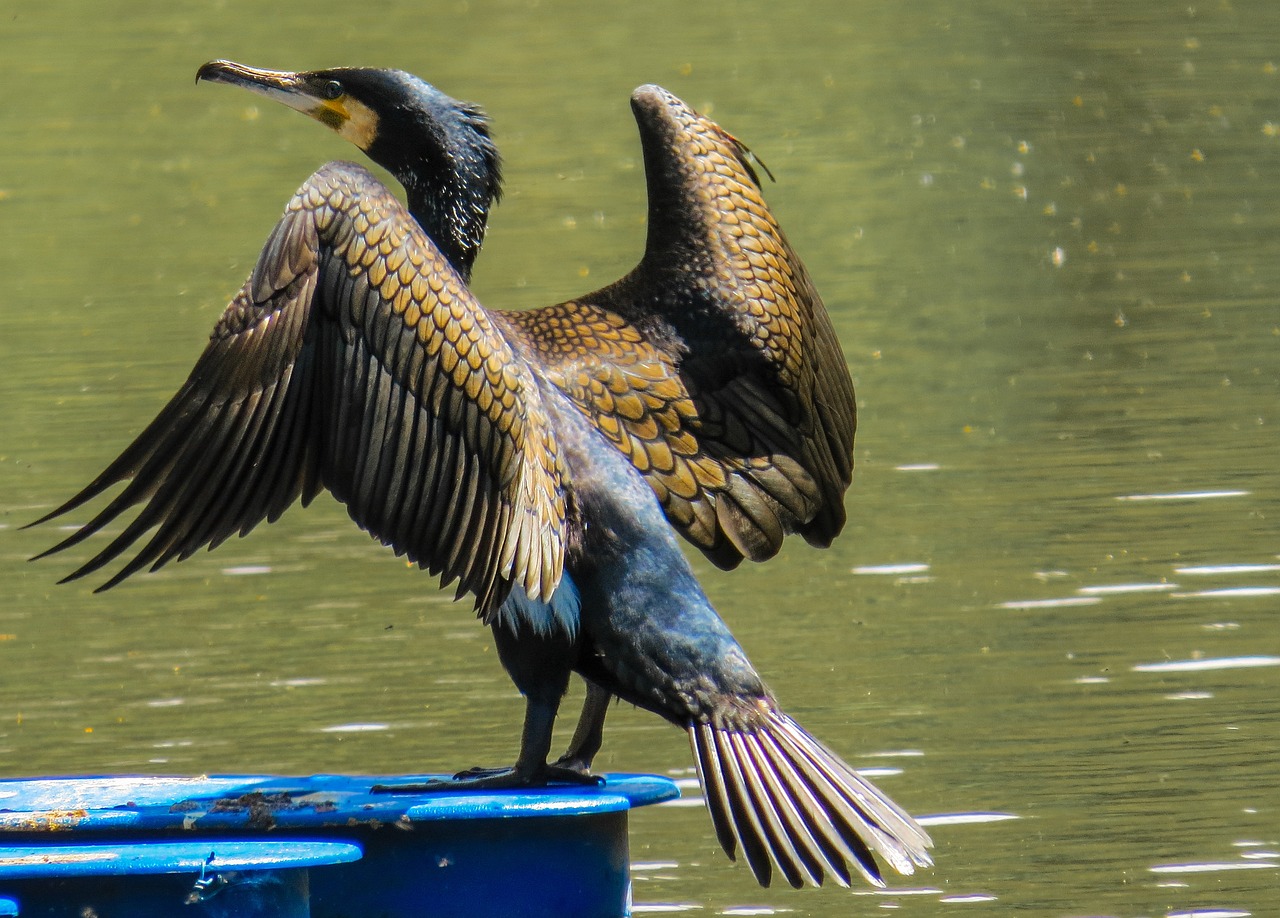The Cormorant: A Symbol of Spiritual Significance

Hey there, amazing readers! 🖐️ Just a quick note: yes, we know there are a lot of ads here. Trust us, we get it—it’s not the prettiest look, but they help us keep this blog alive and kicking. Those pesky little ads cover the costs of all the behind-the-scenes magic, from hosting and tech stuff to creating content we hope you’ll love.
We’re committed to delivering quality posts, and your support (even just sticking around despite the ads) means everything to us. So, bear with us, and thanks for helping us keep the good vibes rolling. Now, on to the fun stuff! 😉
TRANSLATE BUTTON AT THE END OF THE ARTICLE
The cormorant, an enigmatic bird that often remains hidden in the shadows of other, more glamorous avian creatures, holds a fascinating spiritual meaning that transcends its seemingly mundane appearance.
This article delves into the depths of the cormorant’s symbolism, exploring its spiritual significance across various cultures, its role in ancient myths and legends, and how its presence can guide us towards profound spiritual insights.
Unveiling the Cormorant’s Spiritual Symbolism
The cormorant, with its distinctive long neck, sharp beak, and sleek black plumage, carries a unique spiritual symbolism that often escapes the casual observer.
Its association with water and air connects it to two fundamental elements, making it a powerful symbol of duality.
The bird’s ability to navigate these realms is akin to our spiritual journey, where we too must navigate the turbulent waters of life while remaining grounded in the ethereal.
Cormorants in Native American Spirituality
In Native American cultures, the cormorant is revered as a messenger between the earthly and spiritual realms.
Its skill in diving deep beneath the surface reflects its connection to the hidden aspects of life, and it serves as a reminder to explore our own depths, both in terms of introspection and self-discovery.
The connection between Native American spirituality and the cormorant runs deep.
Tribes such as the Lakota and Oglala believe that cormorants bring messages from the spirit world, often appearing during important ceremonies or when individuals are seeking guidance.
The belief is that these birds possess a unique ability to bridge the gap between the physical and spiritual planes, offering insights and wisdom to those who are attentive.
Cormorants in Asian Spirituality
In Asian cultures, particularly in China and Japan, the cormorant holds a profound spiritual significance.
It is often associated with the Water God and considered a symbol of transformation and adaptability.
The cormorant’s unique fishing technique, which involves catching fish and then offering them to fishermen, represents the cycle of life, death, and rebirth, emphasizing the importance of giving and receiving.
Cormorants have been featured prominently in Chinese art and literature for centuries.
Their presence in these works often symbolizes the harmonious relationship between humans and nature.
It’s a reminder that, just as cormorants provide for the fishermen, we too should strive for a balanced and symbiotic connection with the world around us.
Cormorants in Ancient Myths and Legends
The cormorant has left its mark in various ancient myths and legends, further underscoring its spiritual importance.
Here, we explore some of the most captivating tales involving this enigmatic bird.
The Cormorant in Celtic Mythology
In Celtic mythology, the cormorant is linked to the god Lir, who ruled the sea and all its creatures.
The cormorant served as Lir’s loyal messenger, delivering messages between the mortal world and the divine.
This connection highlights the bird’s role as a bridge between the mundane and the mystical.
Lir, the Celtic sea god, is often depicted with a cormorant perched on his shoulder, a symbol of his dominion over the seas.
Lir’s association with the cormorant is a testament to the bird’s role as an intermediary between the natural and supernatural realms.
The Cormorant in Greek Mythology
The Greeks, too, had their own interpretation of the cormorant’s significance.
According to legend, the cormorant was the companion of the sea god Poseidon.
It was said to assist sailors and fishermen by guiding them to abundant fishing grounds, reinforcing the bird’s reputation as a guardian and a symbol of providence.
In Greek mythology, the cormorant was believed to be a favored companion of Poseidon, the god of the sea.
The bird was seen as a protector of sailors, guiding them to safe harbors and bountiful catches.
Its presence was considered an omen of good fortune and a reminder of the interconnectedness between humans and the natural world.
Finding Spiritual Guidance through the Cormorant
For those seeking spiritual guidance, the cormorant offers valuable lessons and insights.
By observing this remarkable bird, we can draw parallels between its behavior and our own spiritual journey.
Adaptability and Resilience
One of the key lessons from the cormorant is its adaptability.
These birds are equally at home in the water and the air, teaching us the importance of being flexible in the face of life’s challenges.
Like the cormorant, we must be willing to dive deep into the unknown and emerge stronger and wiser.
Cormorants excel in both the aquatic and aerial realms.
Their adaptability and resilience in navigating these distinct environments mirror our own need to adapt to the ever-changing circumstances of life.
Just as the cormorant can seamlessly transition from the water to the sky, we, too, can learn to embrace change and thrive in diverse situations.
Patience and Persistence
Cormorants are patient hunters, willing to wait for the right moment to strike.
This quality reminds us of the value of patience and persistence in our spiritual endeavors.
It’s a gentle nudge to trust in the timing of our personal growth and transformation.
In the world of cormorants, patience is key.
These birds are known to wait patiently for the perfect opportunity to catch their prey.
This behavior mirrors the importance of patience in our spiritual journeys.
It encourages us to trust in the timing of our personal growth and transformation, knowing that there’s a season for everything.
Embracing Dualities
The cormorant’s connection to both water and air encourages us to embrace our own dualities.
We, too, are beings of both earth and spirit, and finding balance between these aspects of ourselves is essential for our spiritual well-being.
Cormorants embody the concept of embracing dualities.
Their ability to navigate both the water and the air illustrates the importance of balance in our lives.
We are physical beings with spiritual aspects, and finding harmony between these two dimensions is crucial for personal growth and fulfillment.
The Cormorant’s Global Presence
The spiritual significance of cormorants isn’t confined to a single region or culture.
These remarkable birds can be found in various parts of the world, each with its own interpretation of their symbolism.
Cormorants in African Spirituality
In Africa, cormorants are associated with wisdom and foresight.
They are believed to possess the ability to see what others cannot, a trait highly regarded by many African communities.
These birds are considered messengers of truth and enlightenment.
Cormorants in European Spirituality
In Europe, cormorants are often associated with mystery and the unknown.
Their elusive nature and habit of disappearing underwater create an air of enigma, leading some to interpret them as guides through life’s uncertainties.
In Celtic and Norse mythology, cormorants are linked to sea voyages and the exploration of the unknown.
Cormorants in South American Spirituality
South American cultures, particularly in Peru and Chile, revere cormorants as symbols of transformation and adaptability, similar to the beliefs held in Asia.
They are seen as birds that can help individuals navigate the ever-changing waters of life.
Conclusion: Embracing the Cormorant’s Spiritual Wisdom
The cormorant, often overlooked in the grand
tapestry of the natural world, holds a profound spiritual meaning that transcends its unassuming appearance.
Across cultures and mythologies, it is revered as a messenger, guardian, and symbol of transformation.
By studying the cormorant’s behaviors and characteristics, we can draw valuable spiritual lessons on adaptability, patience, and embracing our own dualities.
Frequently Asked Questions
1.
Are cormorants considered good luck in any cultures?
Yes, in some Asian cultures, cormorants are considered symbols of good luck, especially for fishermen.
They are believed to bring prosperity and a bountiful catch.
2.
Can cormorants fly and swim equally well?
Cormorants are excellent swimmers, known for their underwater agility.
While they might not be as graceful in the air as some other birds, they are capable of flight.
3.
How do cormorants catch fish underwater?
Cormorants catch fish by diving underwater and using their sharp beaks to grasp their prey.
They are skilled hunters, capable of catching a variety of fish species.
4.
What is the spiritual significance of cormorants in Native American cultures?
In Native American spirituality, cormorants are seen as messengers between the earthly and spiritual realms.
Their ability to navigate the depths of water reflects the idea of exploring one’s own inner depths and hidden aspects.
5.
How can we apply the lessons from cormorants in our daily lives?
The lessons of adaptability, patience, and embracing dualities that we can learn from cormorants can be applied in various aspects of our lives.
We can use these insights to navigate challenges, grow spiritually, and find balance.
6.
Are cormorants endangered or protected in any way?
The conservation status of cormorant species varies, with some being protected due to declining populations, while others are more abundant.
Conservation efforts are in place to protect their habitats and populations where needed.
7.
Can cormorants live in both saltwater and freshwater environments?
Yes, cormorants are adaptable birds that can thrive in both saltwater and freshwater environments, depending on the species and their geographic range.
8.
What is the significance of cormorants in African spirituality?
In African spirituality, cormorants are associated with wisdom and foresight.
They are believed to possess the ability to see what others cannot, making them messengers of truth and enlightenment.
9.
How are cormorants viewed in European spirituality?
In Europe, cormorants are often seen as symbols of mystery and the unknown.
Their elusive nature and underwater activities contribute to their enigmatic reputation, and they are associated with guiding individuals through life’s uncertainties.
10.
What role do cormorants play in South American spirituality?
In South American cultures, particularly in Peru and Chile, cormorants are revered as symbols of transformation and adaptability, akin to their significance in Asian cultures.
They are seen as guides to help individuals navigate the ever-changing waters of life.

The Enlightenment Journey is a remarkable collection of writings authored by a distinguished group of experts in the fields of spirituality, new age, and esoteric knowledge.
This anthology features a diverse assembly of well-experienced authors who bring their profound insights and credible perspectives to the forefront.
Each contributor possesses a wealth of knowledge and wisdom, making them authorities in their respective domains.
Together, they offer readers a transformative journey into the realms of spiritual growth, self-discovery, and esoteric enlightenment.
The Enlightenment Journey is a testament to the collective expertise of these luminaries, providing readers with a rich tapestry of ideas and information to illuminate their spiritual path.
Our Diverse Expertise 🌟
While our primary focus is on spirituality and esotericism, we are equally passionate about exploring a wide range of other topics and niches 🌍📚. Our experienced team is dedicated to delivering high-quality, informative content across various subjects ✨.
To ensure we provide the most accurate and valuable insights, we collaborate with trusted experts in their respective domains 🧑🏫👩🏫. This allows us to offer well-rounded perspectives and knowledge to our readers.
Our blog originally focused on spirituality and metaphysics, but we’ve since expanded to cover a wide range of niches. Don’t worry—we continue to publish a lot of articles on spirituality! Frequently visit our blog to explore our diverse content and stay tuned for more insightful reads.






